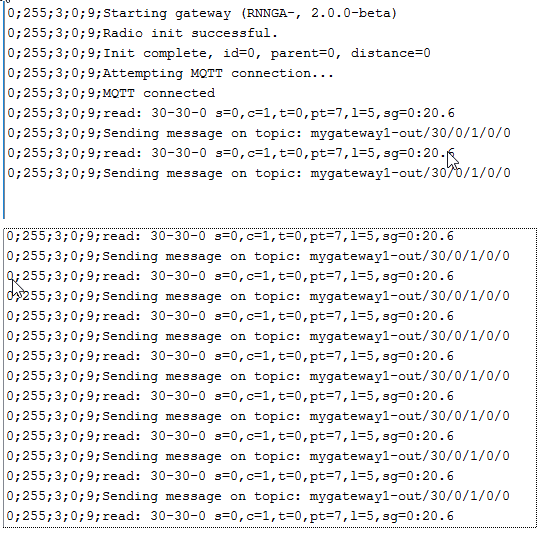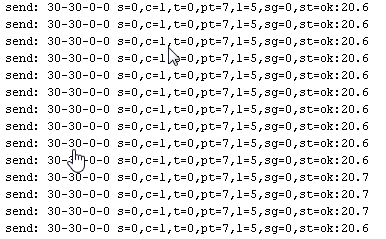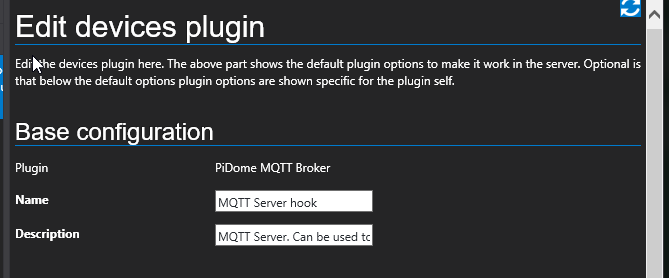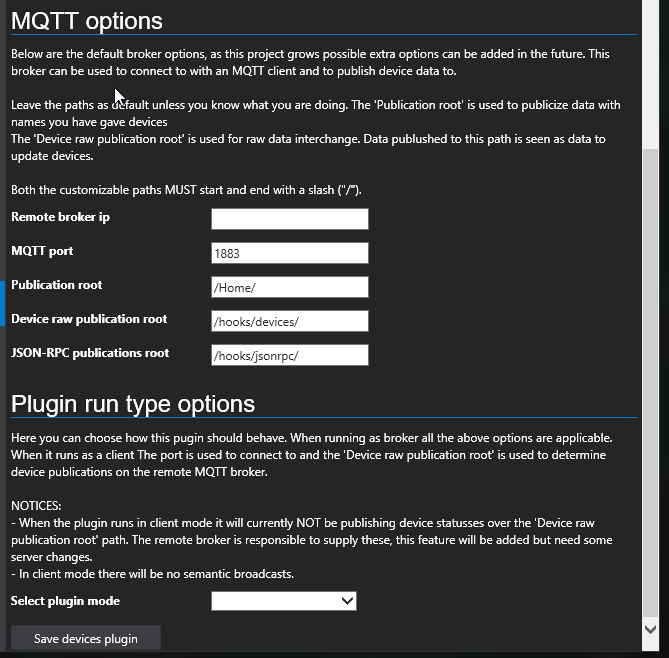How to setup MQTT broker root ?
ARDUINO 1.6.8
MySENSORS ARDUINO LIBRARY V2.0.0-BETA
ARDUINO UNO R3 + W5100 ETHERNETSHIELD + NRF24L01 LONG RANGE
/**
* The MySensors Arduino library handles the wireless radio link and protocol
* between your home built sensors/actuators and HA controller of choice.
* The sensors forms a self healing radio network with optional repeaters. Each
* repeater and gateway builds a routing tables in EEPROM which keeps track of the
* network topology allowing messages to be routed to nodes.
*
* Created by Henrik Ekblad <henrik.ekblad@mysensors.org>
* Copyright (C) 2013-2015 Sensnology AB
* Full contributor list: https://github.com/mysensors/Arduino/graphs/contributors
*
* Documentation: http://www.mysensors.org
* Support Forum: http://forum.mysensors.org
*
* This program is free software; you can redistribute it and/or
* modify it under the terms of the GNU General Public License
* version 2 as published by the Free Software Foundation.
*
*******************************
*
* REVISION HISTORY
* Version 1.0 - Henrik Ekblad
*
* DESCRIPTION
* The W5100 MQTT gateway sends radio network (or locally attached sensors) data to your MQTT broker.
* The node also listens to MY_MQTT_TOPIC_PREFIX and sends out those messages to the radio network
*
* LED purposes:
* - To use the feature, uncomment WITH_LEDS_BLINKING in MyConfig.h
* - RX (green) - blink fast on radio message recieved. In inclusion mode will blink fast only on presentation recieved
* - TX (yellow) - blink fast on radio message transmitted. In inclusion mode will blink slowly
* - ERR (red) - fast blink on error during transmission error or recieve crc error
*
* See http://www.mysensors.org/build/esp8266_gateway for wiring instructions.
* nRF24L01+ ESP8266
* VCC VCC
* CE GPIO4
* CSN/CS GPIO15
* SCK GPIO14
* MISO GPIO12
* MOSI GPIO13
*
* Not all ESP8266 modules have all pins available on their external interface.
* This code has been tested on an ESP-12 module.
* The ESP8266 requires a certain pin configuration to download code, and another one to run code:
* - Connect REST (reset) via 10K pullup resistor to VCC, and via switch to GND ('reset switch')
* - Connect GPIO15 via 10K pulldown resistor to GND
* - Connect CH_PD via 10K resistor to VCC
* - Connect GPIO2 via 10K resistor to VCC
* - Connect GPIO0 via 10K resistor to VCC, and via switch to GND ('bootload switch')
*
* Inclusion mode button:
* - Connect GPIO5 via switch to GND ('inclusion switch')
*
* Hardware SHA204 signing is currently not supported!
*
* Make sure to fill in your ssid and WiFi password below for ssid & pass.
*/
#include <SPI.h>
// Enable debug prints to serial monitor
#define MY_DEBUG
// Enables and select radio type (if attached)
#define MY_RADIO_NRF24
//#define MY_RADIO_RFM69
#define MY_GATEWAY_MQTT_CLIENT
// Set this nodes subscripe and publish topic prefix
#define MY_MQTT_PUBLISH_TOPIC_PREFIX "mygateway1-out"
#define MY_MQTT_SUBSCRIBE_TOPIC_PREFIX "mygateway1-in"
// Set MQTT client id
#define MY_MQTT_CLIENT_ID "mysensors-1"
// W5100 Ethernet module SPI enable (optional if using a shield/module that manages SPI_EN signal)
//#define MY_W5100_SPI_EN 4
// Enable Soft SPI for NRF radio (note different radio wiring is required)
// The W5100 ethernet module seems to have a hard time co-operate with
// radio on the same spi bus.
#if !defined(MY_W5100_SPI_EN) && !defined(ARDUINO_ARCH_SAMD)
#define MY_SOFTSPI
#define MY_SOFT_SPI_SCK_PIN 14
#define MY_SOFT_SPI_MISO_PIN 16
#define MY_SOFT_SPI_MOSI_PIN 15
#endif
// When W5100 is connected we have to move CE/CSN pins for NRF radio
#define MY_RF24_CE_PIN 5
#define MY_RF24_CS_PIN 6
// Enable these if your MQTT broker requires usenrame/password
//#define MY_MQTT_USER "username"
//#define MY_MQTT_PASSWORD "password"
// Enable MY_IP_ADDRESS here if you want a static ip address (no DHCP)
#define MY_IP_ADDRESS 192,168,178,87
// If using static ip you need to define Gateway and Subnet address as well
#define MY_IP_GATEWAY_ADDRESS 192,168,178,1
#define MY_IP_SUBNET_ADDRESS 255,255,255,0
// MQTT broker ip address or url. Define one or the other.
//#define MY_CONTROLLER_URL_ADDRESS "m20.cloudmqtt.com"
#define MY_CONTROLLER_IP_ADDRESS 192, 168, 178, 68
// The MQTT broker port to to open
#define MY_PORT 1883
/*
// Flash leds on rx/tx/err
#define MY_LEDS_BLINKING_FEATURE
// Set blinking period
#define MY_DEFAULT_LED_BLINK_PERIOD 300
// Enable inclusion mode
#define MY_INCLUSION_MODE_FEATURE
// Enable Inclusion mode button on gateway
#define MY_INCLUSION_BUTTON_FEATURE
// Set inclusion mode duration (in seconds)
#define MY_INCLUSION_MODE_DURATION 60
// Digital pin used for inclusion mode button
#define MY_INCLUSION_MODE_BUTTON_PIN 3
// Uncomment to override default HW configurations
//#define MY_DEFAULT_ERR_LED_PIN 16 // Error led pin
//#define MY_DEFAULT_RX_LED_PIN 16 // Receive led pin
//#define MY_DEFAULT_TX_LED_PIN 16 // the PCB, on board LED
*/
#include <Ethernet.h>
#include <MySensor.h>
void setup() {
}
void presentation() {
// Present locally attached sensors here
}
void loop() {
// Send locally attech sensors data here
}
ARDUINO NANO + NRF24L01
DallasTemperature Sensor
/**
* The MySensors Arduino library handles the wireless radio link and protocol
* between your home built sensors/actuators and HA controller of choice.
* The sensors forms a self healing radio network with optional repeaters. Each
* repeater and gateway builds a routing tables in EEPROM which keeps track of the
* network topology allowing messages to be routed to nodes.
*
* Created by Henrik Ekblad <henrik.ekblad@mysensors.org>
* Copyright (C) 2013-2015 Sensnology AB
* Full contributor list: https://github.com/mysensors/Arduino/graphs/contributors
*
* Documentation: http://www.mysensors.org
* Support Forum: http://forum.mysensors.org
*
* This program is free software; you can redistribute it and/or
* modify it under the terms of the GNU General Public License
* version 2 as published by the Free Software Foundation.
*
*******************************
*
* DESCRIPTION
*
* Example sketch showing how to send in DS1820B OneWire temperature readings back to the controller
* http://www.mysensors.org/build/temp
*/
#include <MySensor.h>
#include <SPI.h>
#include <DallasTemperature.h>
#include <OneWire.h>
#include <MyHwATMega328.h>
#define COMPARE_TEMP 0 // Send temperature only if changed? 1 = Yes 0 = No
#define ONE_WIRE_BUS 3 // Pin where dallase sensor is connected
#define MAX_ATTACHED_DS18B20 16
#define RF24_CE_PIN 9 /*CE pin */
#define RF24_CS_PIN 10 /* CS pin, using 10 */
/* NRFRF24L01 radio driver (set high transmit power by default) */
MyTransportNRF24 radio(RF24_CE_PIN, RF24_CS_PIN, RF24_PA_LEVEL);
unsigned long SLEEP_TIME = 10000; // Sleep time between reads (in milliseconds)
MyHwATMega328 hw; /* Construct MySensors library */
OneWire oneWire(ONE_WIRE_BUS); // Setup a oneWire instance to communicate with any OneWire devices (not just Maxim/Dallas temperature ICs)
DallasTemperature sensors(&oneWire); // Pass the oneWire reference to Dallas Temperature.
MySensor gw(radio, hw); /* Construct MySensors library */
float lastTemperature[MAX_ATTACHED_DS18B20];
int numSensors=0;
int node_id = 30; /* set node ID here for manual */
boolean receivedConfig = false;
boolean metric = true;
// Initialize temperature message
MyMessage msg(0,V_TEMP);
void setup()
{
// Startup up the OneWire library
sensors.begin();
// requestTemperatures() will not block current thread
sensors.setWaitForConversion(false);
// Startup and initialize MySensors library. Set callback for incoming messages.
gw.begin(NULL,node_id);
// Send the sketch version information to the gateway and Controller
gw.sendSketchInfo("Temperature Sensor", "1.1");
// Fetch the number of attached temperature sensors
numSensors = sensors.getDeviceCount();
// Present all sensors to controller
for (int i=0; i<numSensors && i<MAX_ATTACHED_DS18B20; i++) {
gw.present(i, S_TEMP);
}
}
void loop()
{
// Process incoming messages (like config from server)
gw.process();
// Fetch temperatures from Dallas sensors
sensors.requestTemperatures();
// query conversion time and sleep until conversion completed
int16_t conversionTime = sensors.millisToWaitForConversion(sensors.getResolution());
// sleep() call can be replaced by wait() call if node need to process incoming messages (or if node is repeater)
gw.sleep(conversionTime);
// Read temperatures and send them to controller
for (int i=0; i<numSensors && i<MAX_ATTACHED_DS18B20; i++) {
// Fetch and round temperature to one decimal
float temperature = static_cast<float>(static_cast<int>((gw.getConfig().isMetric?sensors.getTempCByIndex(i):sensors.getTempFByIndex(i)) * 10.)) / 10.;
// Only send data if temperature has changed and no error
#if COMPARE_TEMP == 1
if (lastTemperature[i] != temperature && temperature != -127.00 && temperature != 85.00) {
#else
if (temperature != -127.00 && temperature != 85.00) {
#endif
// Send in the new temperature
gw.send(msg.setSensor(i).set(temperature,1));
// Save new temperatures for next compare
lastTemperature[i]=temperature;
}
}
gw.sleep(SLEEP_TIME);
}```
Serial log MQTTgateway

Serial log sensor

Pidome


